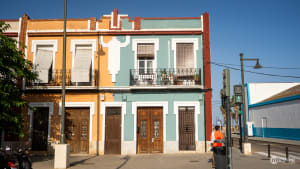
Fallas Frequently Asked Questions
What is Fallas exactly, why do people care about them so much, what are all of these events? All your doubts about Fallas cleared up.
Fallas is Valencia’s most celebrated festival, drawing millions of visitors each March. These frequently asked questions address common inquiries people have when learning about this unique cultural event.
Throughout these answers, you’ll find information about what Fallas is, its historical origins, and the schedule of events. We explain the impressive sculptures that give the festival its name, where to find them, and key traditions like the Mascletàs, Ofrenda de Flores, and the final night’s Cremà. Each answer includes links to dedicated articles where you can find more detailed information about specific aspects of the festival.
-
Fallas (or Falles in Valencian) is probably the most important festivity in Valencia. It is a traditional festival held every year in March all over the Valencia region. The biggest and most famous version of the festival is the one that takes place in Valencia city. The event is even recognised as Intangible Cultural Heritage by UNESCO .
The Fallas’ origins are ancient and heavily debated. According to some, the festival is a descendant of pre-Christian spring celebrations. According to others, Fallas was initially a celebration day for the many carpenters in the city on the occasion of their saint patron (Saint Joseph) day on the 19th of March.
In any case, the festival nowadays consists of several days of fireworks and parades that culminate in the positioning of massive sculptures (called fallas) all over the city. On the final day, all the sculptures are burnt in massive bonfires. In fact, the word falla comes from the Latin facula, meaning torch.
If you’d like to know more about Fallas, you can have a look at our introductory article.
-
Fallas takes place every year roughly from the 1st to the 19th of March. However, the festival takes all year to prepare and fundraise, and many opening events, like the Crida and the Cordà, take place at the end of February.
Officially, the core of the festival is the Semana Fallera, from the 15th to the 19th of March. These are the most eventful and final days of celebrations. The fallas (sculptures) can be seen all over the city in these last days.
The Fallas calendar includes many events throughout the three weeks of its duration. If you want to have a look at them, you can check out our Fallas calendar.
-
The key events during Fallas are certainly the Cremà (the final bonfire), the Plantà (the moment when the fallas are placed around the city), the daily Mascletàs (day-time fireworks), and the opening ceremony, the Crida.
However, there are many other important and beloved ceremonies and occasions during these three weeks. Some of the most well-known are the flower offering Ofrenda de Flores, the firework display Nit del Foc, the allegorical parade Cabalgata del Fuego, and the streetlight installations encendidos de luces.
If you want to check out all Fallas events, have a look at our Fallas calendar.
-
The fallas are large sculptures usually made of papier-mâché, wood, and other lightweight materials like expanded polystyrene or cork. The point of these sculptures, made by specialised artists called artistas falleros, is to create a scene, composed by various figures called ninots (meaning puppets), that satirise and comment on current political or social events.
The fallas are distinguished into two types. Some are made with an adult audience in mind, in which case they’re bigger in size and called fallas mayores. The other ones are the fallas infantiles and are smaller and made for kids, therefore referencing cartoons or children’s games.
The fallas mayores are set up in the city on the night between the 15th and the 16th of March, while the fallas infantiles the day before. Thousands of people flock to the streets to see as many of the 784 fallas as they can before they are all burnt on the night of the 19th, for the Cremà.
-
Yes, absolutely. We cannot stress this enough, if you want to visit Valencia during Fallas, you have to book as soon as you can! Valencia receives millions of visitors in the Fallas weeks alone, so places fill up quickly.
That means that you start looking for a place ten days before the festival, not only you won’t find a decently-priced place to stay, you won’t find one at all. Fallas really is worth a visit, so we recommend it wholeheartedly, but it’s essential that find accommodation ahead of time. You can find and reserve a hotel or apartment here.
-
Before the fallas are put on the streets in Valencia (during the Plantà on the 15th of March), they are built in spacious warehouses. Most of these are located in the Ciudad del Artista Fallero neighbourhood.
The sculptures are then taken to the streets, assembled, and the finishing touches are added. Some parts of the fallas though, leave the warehouses much earlier than the rest. These are the ninots that will enter the Exposició del Ninot.
This exhibition determines which puppets will become ninots indultats and be spared from the flames. All the other ninots are returned to their fallas before being set up in the streets. You can see all the winning ninots (from 1934) in the Museu Faller.
-
Every year, there are a few fallas that are noticeably bigger than the rest. Many people make a point of visiting all these fallas, as they are the most spectacular ones. These are the sculptures with the biggest budget, classified as Sección Especial, as well as the fallas in Plaza del Ayuntamiento. This last one is called falla municipal and doesn’t compete in any category.
There usually are around ten fallas in this category. Although new participants can enter the category every year, they normally are Convento de Jerusalén, Plaza del Pilar, Na Jordana, Exposición, Almirante Cadarso, Reino de Valencia- Duque de Calabria, Sueca- Literato Azorín, Cuba- Literato Azorín, L’ Antiga de Campanar, and Malvarrosa.
If you want to know specifically how to reach each top category falla, have a look at our article.
-
Yes, they are all burnt, not even the fallas that win the first prize in their category are spared from the fire during the Cremà. In fact, burning is the whole point of these sculptures, and they are designed to burn in a specific way. Only parts of the fallas are spared from the fire.
Those are the ninots that win the Exposició del Ninot or that are taken as souvenirs by the Fallera Mayor or other official figures of the Fallas committees.
-
A Mascletà is a daily pyrotechnic display during Fallas. Its purpose is to produce as much noise as possible and create a rhythm. There are two types of Mascletàs in Valencia: diurnas (daytime) or nocturnas (nighttime).
The most famous is the Mascletà diurna which takes place in Plaza del Ayuntamiento every day at 2:00 pm between the 1st and the 19th of March. The display only lasts around 10 minutes, but it draws massive crowds and reaches deafening volumes. There also are smaller mascletàs celebrated in the different committees’ neighbourhoods every day at the same time.
If you’d like to know more about this event, you can check out the dedicated article.
-
The Ofrenda de Flores is a widely popular event flower offering during Fallas. The Ofrenda sees hundreds of falleras and falleros parading to honour the patron saint of Valencia, the Virgin of the Forsaken. For two days, you’ll see the city’s streets full of people in their traditional dresses. Each of them will be carrying flowers means as a gift to the Virgin. At the end of the parade, the bouquets are gathered to form the mantle that covers a huge statue of the Virgin, located in Plaça de la Mare de Déu.
The Ofrenda’s parade takes place every year on the 17th and 18th of March, starting at 3:30 pm and ending at around 1:00 am. Interestingly enough, this is one of the very few religious events in Fallas. However, many people simply go in the spirit of tradition and enjoy the atmosphere of joy and great emotion.
If you’d like to know more about this event, you can check out the dedicated article.
-
The Exposició del Ninot is a yearly exhibition in which the public gets to choose which ninots they want to spare from the flames of the Cremà. The Exposició del Ninot is held in the Museo de Ciencias Príncipe Felip in the City of Arts and Sciences, normally from February until the 14th of March.
A ninot is a figure that is part of a falla scene. It is an individual, free-standing satirical figure, usually in the shape of a popular character or famous person. The winning figures are then called Ninots Indultats.
The Ninots Indultats are then taken to the Museu Faller, while the others are taken back to their fallas of origin in an act called Recogida del Ninot. This is a very festive, loud, and cheerful event, albeit lesser well-known than other Fallas events.
If you’d like to know more about this event, you can check out the dedicated article.
-
The Crida is the official opening ceremony of every year’s Fallas festival. The word crida is Valencian for “act of calling”. The event is a call for the city and visitors to participate in the celebrations.
The Crida is celebrated on the last Sunday in February at 8:00 pm in Plaza de la Crida, in front of the Serranos Towers. The ceremony mainly consists of a speech, given by the city’s mayor and the Fallera Mayor and a firework display.
Aside from these main events, there also are music, singing, maybe dancing or small theatrical performances and a light show. After all this, all the gathered participants sing the Valencian anthem and parade to the church in Plaza de la Virgen.
If you’d like to know more about this event, you can check out the dedicated article.
-
The Plantà is the act of putting up the fallas sculptures before the final days of the festival, the Semana Fallera. This is not as much of an official event with a ceremony, but rather something that is highly anticipated for its result - the fallas being finally out in the streets.
There are actually two Plantàs - the one for the adult fallas is between the 15th and 16th of March. For the fallas infantiles, it’s a day early, between the 14th and the 15th of March. However, in the case of the biggest fallas - like the ones in the Sección Especial, the Plantà actually begins several days early. This is because the sculptures are so large and complex that they require several days to assemble.
If you’d like to know more about this event, you can check out the dedicated article.
-
Nit del Foc, which literally means Night of Fire, is the biggest and longest firework display of Fallas. The display is normally held at night between the 18th and the 19th of March at 1:30 am, between Puente de la Exposición and Puente de las Flores.
This event is highly anticipated and draws huge crowds of Valencianos, visitors, adults, and children. The show itself lasts around 20 minutes, making it the longest firework display in the festival.
If you’d like to know more information about the event, read our dedicated article.
-
Yes, there are many nighttime events during fallas. Many of them are family favourites, like the Castillos de Fuegos Artificiales, the Mascletàs nocturnas (both firework displays) and the streetlight installations.
Other events are more catered towards adult audiences, with the open-air discos and parties, the Verbenas and discomoviles.



















